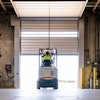Think of every footfall, every day, of every steel-toed shoe that traverses the average production floor. Then add forklifts, pallet jacks, workstations, dropped tools, and modular everything, and you’re looking at one beat up slab of concrete.
The typical problem with plant flooring is that it’s nearly impossible to replace without a major shutdown, meaning most plants elect to address the problems of an existing floor with patch work, seals, chemicals or coverings. There’s a lot out there to choose from, so what’s the best solution for you?
Set In Concrete?
The first question you may need to answer is whether you’re working with a contaminated substrate. According to Kelly Mortensen, president of Flooring Adventures, manufacturer of Tuff-Seal Tile, 95 percent of industrial applications have a contaminated slab or moisture problem.
“Those two are really big issues when it comes to epoxy coatings — or really anything that is being adhered to the concrete, because any contaminants that are in there will be a bond breaker, so they can’t stick to the concrete,” Mortensen explains. “If you have a moisture vapor problem, you have moisture coming up through the soil and into the concrete. That causes a bonding problem, and with epoxies, typically what you’ll see is it will peel right off the surface of the concrete. If it’s a product that’s glued onto the concrete, like a ceramic or vinyl tile, the first thing it will do is re-emulsify the adhesives, or turn them back into a liquid. Or, if you use a waterproof adhesive — like an epoxy or polyurethane — it has the same effect as the epoxy coating does. It just will release and you can’t stick to it.”
Seeing the lack of effectiveness of epoxies on contaminated substrates spurred Flooring Adventures to create what it refers to as “an ideal floor.” The resulting Tuff-Seal Tile features a patented hidden interlock. Once the tiles are tapped together, the interlocks are hidden, resulting in a smooth, seamless look that won’t shift, deflect or separate.
This covering is ideal, according to Mortensen, because it can lay right over the top of a contaminated floor. For moisture problems, the surface of the concrete must be scarified or shot blasted before laying the tile. Then when vapor hits the floor covering, it begins to condense and turn into a liquid. “If the surface of the concrete is porous, when that vapor condenses and turns into a liquid, the concrete will re-absorb it again,” explains Mortensen.
According to Erick Schuetz, Senior Marketing and Sales Manager for Safeguard Technology, old and compromised concrete steps can also be retrofitted to obtain some safety benefits, but may eventually need replacing. “In the case of concrete steps that are disintegrating, prior to covering an eroded surface, some patching or repair may be necessary. There is no way around it. Eventually, the surface will require replacement but it is a costly investment to replace an entire stairwell or floor area. It really depends on the extent of damage,” Schuetz says.
Get A New Coating
When looking at other materials, such as metal used in floor plate, grating, or stairs, textured coatings can serve as a great way to retain the existing material without losing safety benefits.
According to Andrew Towns of Carbinite Metal Coatings, the company’s landmark product — Carbinite, a textured tungsten carbinite coating — can create superior bond strength as compared to some other types of textured coatings. “This coating can be applied to almost any metal so it is great for use on floor plate, grating, and stairs,” Towns explains. “We can take floor plate or diamond tread that has been worn to a gloss finish and give it better grip that it had when it was installed new.”
This coating was initially developed in the 1950s for the purpose of extending tool and die life expectancy. In some cases the life was extended up to eight times as long as the same die was left untreated. In 1997, Carbinite began developing new technology to reduce turn around time and increase both application consistency and bond strength. Over the years, the company has discovered a number of new applications for the Carbinite technology.
Safety Benefits
Some coverings have specific safety benefits to offer which, says Towns, can translate into big savings through accident-prevention. “The cost of slip resistant flooring materials will easily pay for it self if you can avoid one slip, trip, or fall,” he explains. “The goal of workplace safety is to eliminate these accidents from happening and the fist step is providing a safe work environment.”
Other intangibles, like worker confidence, can add to the bottom line. For a company like Safeguard Technology, the value of an anti-slip floor cover will both eliminate the need for a costly construction project, but it will also provide a safe working and walking environment for employees. “What is not always recognized is the boost in morale and the benefit to the bottom line when a safe working environment is established,” says Schuetz. “Statistics, and common sense, prove that production increases when a healthy, confident worker is able to perform their tasks. When an employer takes an interest in the welfare of his or her associates, it is a win-win for everyone.”
Practically Speaking
Ultimately, common sense also plays a role in the ability for a floor to stand the test of time, as well as retain its safety benefits. “Regular housekeeping is imperative,” says Schuetz. “Remove any debris, contaminants, and obstacles that can lead to a slip, trip, or fall.”
For Tuff-Seal Tile, overzealous fork truck drivers can cause even the best floors to need work. “We’ve been making this product for 12 years, and I haven’t had one wear-out yet.” says Mortensen. “We’ll see them get abused, of course. One thing (the material) doesn’t like is when a fork truck driver sits there and spins his tires, because you have a great coefficient of friction, so if they spin their tires, they could actually melt the floor.”
Flooring Safety Checklist
According to Erick Schuetz, marketing and sales manager for Safeguard Technology, there are a few recommended techniques for assessing the safety of a manufacturer’s current floors or stairs. Says Schuetz:
Before I assess any area, I consider the following:
- Acknowledge the location of your steps/floors: Are they interior or exterior? How does the geographic region affect exterior steps? Is it a warm southern climate with little fluctuation in temperature or weather patterns, or is it subjected to snow, ice, rain, and rapid weather changes?
- Is the substrate we are addressing:
- Concrete?
- Wood?
- Grating?
- Steel? — It must be noted that Diamond or Checker Plate is promoted as an Anti-Slip solution which is a very dangerous misconception. When a contaminant such as oil, dust, water or any type of moisture is introduced, the surface is extremely slippery with a low coefficient of friction.
- Are the steps/floors subjected to contaminants? These might include water, oil/grease, snow, mud, dust or material specific to the industry or manufacturing facility (i.e. byproducts in a food processing plant).
- What is the amount of foot traffic in the area? Is this is a high-traffic area or only occasionally accessed?
- Is this area accessed only by foot traffic or is the surface subjected to heavy equipment as well?
- What types of footwear are worn in these areas?
- Work boots or shoes
- Office footwear including high heels
Once these are addressed I proceed with the following:
- Visual Inspection:
- Can you see debris or material on the surface that can be swept away or removed? This may also include a previous Anti-Slip solution such as tape that is worn off or peeling, as well as an Anti-Slip paint that has delaminated.
- Is the surface worn or damaged? Serrated grating or any steel grating will wear over time, exposing a slippery metal surface. The leading edge of a step is the most critical area. This is where most slips-and-falls occur. Even dry, worn diamond plate can be slippery.
- If concrete, is it chipping or falling apart?
- If wood, is there rotting or splintering?
- Is the surface level?
Other than a quality Anti-Slip surface, regardless of what substrate you are addressing, contaminants create a potential slip, trip, or fall.
- History:
If an accident has ever occurred in this area, it is cause for immediate action. If there is any indication of a potential slip, trip, or fall, the surface must be addressed. Being proactive is imperative. Although there appears to be a shift in philosophy, I continue to field calls from people reacting to a slip-and-fall accident. The injury, workers compensation claim, and/or lawsuit have already occurred.
- Walk & Talk:
It is important to obtain knowledge of the area of concern. Obviously you want to take care while walking on the surface, but until you experience the situation first hand, you are only speculating. Speak with the personnel that work in that area. They are the experts when defining the needs. What duties are they performing when accessing the area? Are they simply traveling from one area to another? Are they performing a job function, or transporting material that may inhibit the ability to maintain their balance or catch themselves should a slip occur?
For more information, please visit www.impomag.com.






















